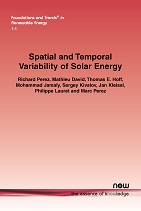Spatial and Temporal Variability of Solar Energy
By Richard Perez, University at Albany, SUNY, USA, rperez@albany.edu | Mathieu David, University of La Réunion, France, mathieu.david@univ-reunion.fr | Thomas E. Hoff, Clean Power Research, USA, tomhoff@cleanpower.com | Mohammad Jamaly, University of California, USA, smjamaly@ucsd.edu | Sergey Kivalov, University at Albany, SUNY, USA, skivalov@albany.edu | Jan Kleissl, University of California, USA, jkleissl@ucsd.edu | Philippe Lauret, University of La Réunion, France, philippe.lauret@univ-reunion.fr | Marc Perez, MGH-Energy, France, mjp2167@columbia.edu
Abstract
This monograph summarizes and analyzes recent research by the authors and others to understand, characterize, and model solar resource variability. This research shows that understanding solar energy variability requires a definition of the temporal and spatial context for which variability is assessed; and describes a predictable, quantifiable variability-smoothing space-time continuum from a single point to thousands of kilometers and from seconds to days. Implications for solar penetration on the power grid and variability mitigation strategies are discussed.
Spatial and Temporal Variability of Solar Energy
Unlike conventional electrical power generation (such as fossil or nuclear enevery), solar energy is intermittent. The output of a solar power plant is driven by weather and by the cycle of days and seasons. It varies from zero to full power outside the control of plant operators.
Spatial and Temporal Variability of Solar Energy summarizes and analyzes recent research by the authors and others to understand, characterize, and model solar resource variability. This research shows that understanding solar energy variability requires a definition of the temporal and spatial context for which variability is assessed; and describes a predictable, quantifiable variability-smoothing space-time continuum from a single point to thousands of kilometers and from seconds to days. It also discusses the implications for solar penetration on the power grid and variability mitigation strategies.
